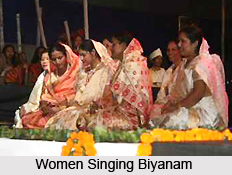 Biyanams are the Assamese wedding songs and which form an integral part of the traditional Assamese wedding, from beginning to end. Assamese literature of the ancient times is rich in Biyanams or marriage songs. Marriage is an elaborate process and consequently, it has inspired a considerable number of songs. Most of these songs are of a documentary character and do not have much of symbolic significance. However, they comprise a very important part of marital celebrations and are sung on almost every ceremony. The rituals for both the bride and her groom are attended by songs of haunting melody.
Biyanams are the Assamese wedding songs and which form an integral part of the traditional Assamese wedding, from beginning to end. Assamese literature of the ancient times is rich in Biyanams or marriage songs. Marriage is an elaborate process and consequently, it has inspired a considerable number of songs. Most of these songs are of a documentary character and do not have much of symbolic significance. However, they comprise a very important part of marital celebrations and are sung on almost every ceremony. The rituals for both the bride and her groom are attended by songs of haunting melody.
Features of Biyanams
The term Biyanam has been derived from two words `Biya` which refers to wedding in Assamese and `Naam` which means songs. These songs are sung by both bride and groom sides separately in different occasions. Biyanam reflects the traditions and practices of Assamese society. Religious believes have a profound impact on these songs and they also narrate Hindu mythological tales associated with marriage. Both tragic and hilarious elements can be found in them. Another feature of Biyanam is that they are sung only by women, belonging to all ages. Imaginations and melodies of women in Assam are truly depicted through these songs.
Common Biyanams of Assamese Wedding
The girl finished her bath. And asked her mother: What clothes shall I put on?
The mother says-
Put on such a cloth
That dries up in the shade,
And can be pressed into the palm.
In another marriage-song, the beauty of the girl is emphasised thus-
Why are you making her up
With tamarind paste?
She is herself a kelaki blossom.
Mythological Associations of Biyanams
There are a number of marriage songs which contain direct references to epic legends. They are indispensable in a number of different marriage rituals, and are believed to render a sort of spiritual significance to the marital life of the couple. There are graceful nuptial songs that describe mythological marriage scenes of Hara-Gauri, Rama-Sita, Usha-Aniruddha and the like, rising almost to lyrical raptures. An ancient religious culture intermingling with folk art can be clearly seen in these songs. Lord Rama symbolises the ideal man for nuptial life and Sita the ideal woman, Lord Shiva and Parvati approximating to them closely. There are also songs that distinctly reveal influences of Vaishnava sentiment and expression.
Joranams
There is a class of marriage-songs called Joranams, i.e., teasing songs. Though invariably offensive in language and spirit, these are merry songs of an innocent nature against the serene and serious background of the marriage ritual. It is felt that these taunting and mocking songs result in the release of repressed energy.
The bridegroom`s sister
Sits with the people,
With her head wide as a basket;
The people are afraid of her,
Lest some goblin has come.




















